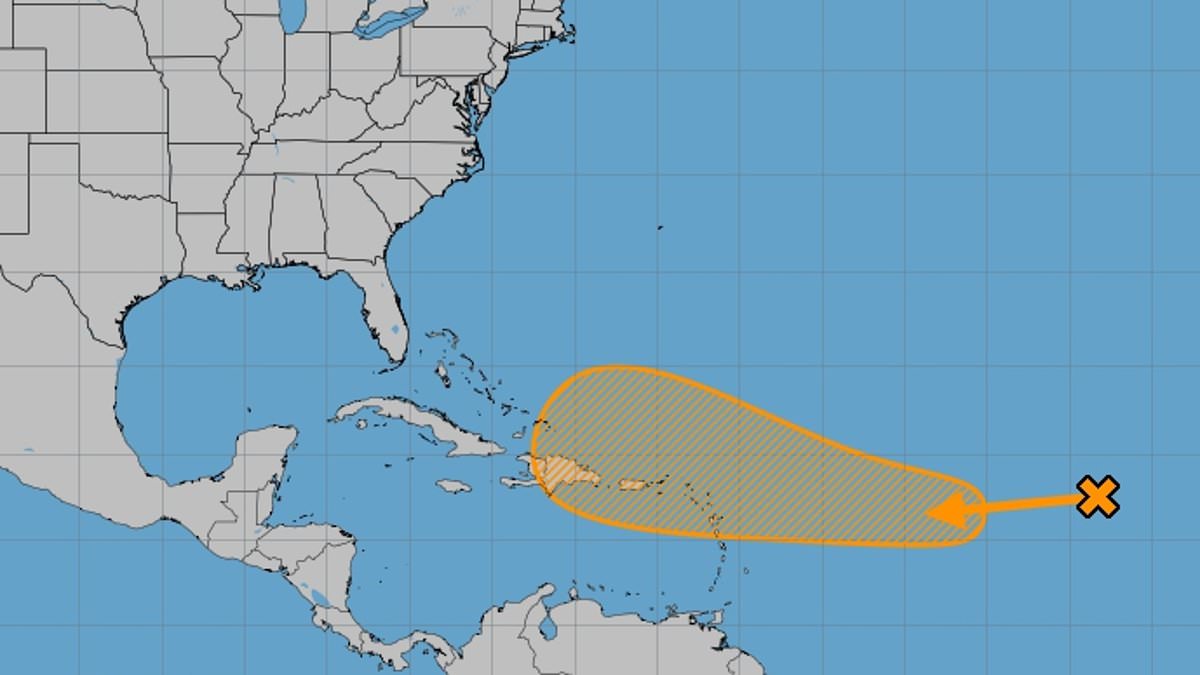Florida could see another hurricane in the next week as tropical storm ‘Nadine’ moves through the Atlantic.
The National Hurricane Center (NHC) issued an update Monday at 8am ET that showed the storm had a 50 percent chance of becoming a hurricane, but increased the odds at 2pm ET to 60 percent.
Meteorologists said that Nadine’s path is still being monitored and it could hit the Sunshine State within the next 10 days or take another route toward Mexico and Central America.
This comes just days after Hurricanes Helene and Milton rocked the southeast coast, bringing torrential flooding and tornadoes from Florida up to North Carolina.

A tropical depression is making its way toward Florida and could be upgraded to a hurricane in the coming days
‘The system is forecast to move generally westward toward warmer waters, and environmental conditions could become more favorable for gradual development by the middle to latter part of this week,’ the NHC shared in the 2pm ET update.
The tropical depression is currently located several hundred miles west of the Cabo Verde Islands but could gradually develop into a hurricane as it reaches the warmer waters near Florida.
NHC previously categorized the storm, formally known as ‘Invest 94L,’ as a disturbance, but has since upgraded it to a tropical depression after its surface winds reach 38 miles per hour that created cyclones on the Atlantic.
When it approaches warmer waters, a depression brings devastating rain and thunderstorms that cause severe floods and can develop into a hurricane if it reaches 74-mile-per-hour winds.
Read More
Influencer who live streamed himself jumping into raging river during Hurricane Milton speaks out

It’s unclear if the tropical storm will definitively develop into a a hurricane or when, but meteorologists are continuing to monitor it as it approaches the coast.
The NCH also said the storm has a 10 percent chance of growing into a hurricane within the next 48 hours.
AccuWeather meteorologist Alex DaSilva told DailyMail.com that the storm will have to be monitored over the next couple days, but it’s unlikely that it will reach hurricane status.
As the storm passes over the Virgin Islands, the mountains could disrupt its growth.
He added that ‘there is a low chance of direct impact to the US because there’s a wind shear that might protect us.’
A wind shear consists of strong upper-level winds that can remove the heat and moisture from the eye of a hurricane and distort its shape, effectively ripping it apart.
If the storm were to develop into something bigger, DaSilva said it likely won’t occur until October 17 through 18 and they won’t know which path the storm will take until then.
‘I don’t think would it would hit us at all,’ he said, adding that ‘it will either just be pushed out to sea or nothing left by the time it gets to the US.’
However, the storm is still very far out and if it does impact the States, it wouldn’t be for another 10 days, ‘so things can still change,’ DaSilva said.
The storm’s strength depends on how long it spends over water which could allow it to grow and develop into a hurricane.
‘One possibility would take the system westward into Central America and southern Mexico, and the other is, unfortunately, toward Florida,’ DaSilva said in an AccuWeather report.
If the tropical depression moves toward Central America, it won’t have as much time to strengthen, but if it’s path shifts northern toward the Gulf of Mexico, it could provide the climate needed to grow.
‘Not only are waters very warm in this area—well into the 80s Fahrenheit down deep- the ocean heat content in the western Caribbean is at record high levels for any time of the year,’ DaSilva said in the report.
The impending storm comes as Florida is working to recover from Hurricane Milton which hit Tampa and traveled across the state last week and triggered deadly tornadoes.
At least 17 people were killed in Florida and while the state is still assessing the financial toll, the damages are estimated to be in the billions.
Milton also came after Hurricane Helene which struck the southeast two weeks prior, leaving states up and down the coast under water.
Helene cost between $30.5 billion and $47.5 billion in total damages across 16 states, according to CoreLogic, and has so far claimed the lives of more than 230 people, with countless others still reported missing.
This year has already seen above average hurricanes for mid-October, with four major hurricanes including Beryl, Helene, Kirk and Milton hitting the US.
In May, National Oceanic and Atmospheric Administration (NOAA) reported that the US would have an above-average hurricane season and predicted between four and seven Category 3 or higher hurricanes would strike.
The prediction so far has proven true, with mid-October seeing above historical averages.
The hurricane season extends from June 1 through November 30.
DailyMail.com has reached out to the National Hurricane Center for comment.
